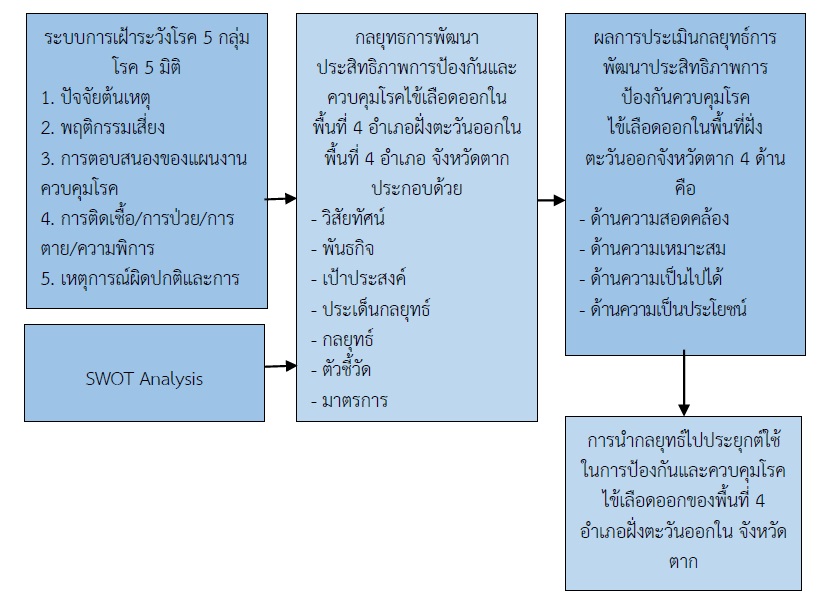กลยุทธ์การพัฒนาประสิทธิภาพการป้องกันและควบคุมโรคไข้เลือดออก ในพื้นที่ 4 อำเภอฝั่งตะวันออก จังหวัดตาก
คำสำคัญ:
กลยุทธ์, การพัฒนาประสิทธิภาพ, การป้องกันและควบคุมโรคไข้เลือดออกบทคัดย่อ
การวิจัยผสมระหว่างการวิจัยเชิงปริมาณและการวิจัยเชิงคุณภาพนี้เพื่อศึกษาพฤติกรรมสุขภาพ สภาพการปฏิบัติงาน สร้างกลยุทธ์และประเมินกลยุทธ์กลยุทธ์การพัฒนาประสิทธิภาพการป้องกันและควบคุมโรคไข้เลือดออก ในพื้นที่ 4 อำเภอฝั่งตะวันออก จังหวัดตาก ดำเนินการวิจัย 3 ขั้นตอน ได้แก่ ขั้นตอนที่ 1 ศึกษาพฤติกรรมสุขภาพของประชาชน จากการศึกษาเอกสาร และสนทนากลุ่ม เครื่องมือที่ใช้เป็นแบบสรุปประเด็นตามเนื้อหา ศึกษาสภาพการปฏิบัติงาน จากกลุ่มตัวอย่าง 360 คน เครื่องมือที่ใช้เป็นแบบสอบถาม ศึกษาประสิทธิภาพการป้องกันและควบคุมโรคไข้เลือดออก จากกลุ่มตัวอย่าง 30 คน และการใช้แบบสัมภาษณ์แบบมีโครงสร้าง ขั้นตอนที่ 2 พัฒนากลยุทธ์โดยการประชุมเชิงปฏิบัติการก่อนยกร่างกลยุทธ์และตรวจสอบร่างกลยุทธ์โดยการสัมมนาอิงผู้เชี่ยวชาญ และขั้นตอนที่ 3 ประเมินกลยุทธ์ โดยใช้แบบประเมิน วิเคราะห์ข้อมูลโดยสถิติเชิงพรรณนา และการวิเคราะห์ SWOT Analysis ผลการวิจัย พบว่า
1. พฤติกรรมสุขภาพของประชาชนในพื้นที่ 4 อำเภอฝั่งตะวันออกของจังหวัดตาก พบว่า ประชนขาดความต่อเนื่องและการมีส่วนร่วมในการปฏิบัติตนในการป้องกันและควบคุมโรคไข้เลือดออก ไม่มีระบบป้องกันไม่ให้ผู้ป่วยเกิดภาวะแทรกซ้อน และแนวทางการส่งต่อผู้ป่วย สภาพการปฏิบัติงานในการป้องกันและควบคุมโรคไข้เลือดออก พบว่ามีการดำเนินงานแต่ไม่ครบถ้วน และไม่ครอบคลุมกระบวนงาน ด้านปัจจัยที่เกี่ยวข้องทั้งภายในและภายนอกพบว่า นโยบายของหน่วยงานและนโยบายด้านการเมืองมีความเกี่ยวข้องมากที่สุด ด้านประสิทธิภาพพบว่า ดำเนินการตามเกณฑ์และตัวชี้วัดที่กำหนดได้ 10 ข้อ จากจำนวน 36 ข้อ
2. กลยุทธ์การพัฒนาประสิทธิภาพการป้องกันและควบคุมโรคไข้เลือดออก ในพื้นที่ 4 อำเภอฝั่งตะวันออก จังหวัดตาก ได้แก่ 1) เพิ่มสมรรถนะของบุคลากรเชิงรุก 2) ปรับกลไกการจัดการความพร้อมของทรัพยากรให้ได้ตามเกณฑ์และตัวชี้วัด 3) พัฒนาระบบและกลไกการบริหารจัดการด้วยวงจรคุณภาพ 4) ปรับเปลี่ยนระบบติดตาม ตรวจสอบ และประเมินผลผ่านระบบสารสนเทศ 5) เสริมสร้างกลไกการประสานงานในการจัดการโรคไข้เลือดออก
3. ผลการประเมินกลยุทธ์การพัฒนาประสิทธิภาพการป้องกันและควบคุมโรคไข้เลือดออกที่พัฒนาพบว่า ความสอดคล้อง ความเหมาะสม ความเป็นไปได้ และความเป็นประโยชน์อยู่ในระดับมากถึงมากที่สุด
ข้อเสนอแนะ ควรศึกษาวิจัยเชิงปฏิบัติการแบบมีส่วนร่วม และศึกษาผลการทดลองใช้กลยุทธ์ เพื่อนำผลวิจัยที่ได้มาพัฒนากลยุทธ์ให้ดียิ่งขึ้น
เอกสารอ้างอิง
Chadthong, K., ChooChom, O., Pakbongkoch, C. & Soadmanee, O., (2011). The Development of a Dengue Hemorrhagic Fever Prevention Model in Nacha-Ung Community, Chumphon Province, Thailand. Journal of Behavioral Science, 17(1), 79-92. (in Thai)
Chokekerd, P., (2018). Strategic Implementation of Dengue Hemorrhagic Fever Prevention and Control by Multisectoral Participation in Chiang Mai Province. Journal of Preventive Medicine Association of Thailand, 8(2), 326-338. (in Thai)
Chumpu, S., Khamsemanan, N. & Nattee, C. (2019). The Association Between Dengue Incident and Provincial-Level Weather Variables in Thailand from 2001 to 2014. PLos ONE, 14(12), 1-27.
Cronbach, L. J. (1951). Coefficient Alpha and the Internal Structure of Tests. Psychometrika, 16, 297-334.
Department of Disease Control. (2015). Manual of Dengue Hemorrhagic Fever Academic for Medical and Public Health. Aksorn Graphic and Design Publishing Limited Partnership. Bangkok. (in Thai)
Department of Disease Control. (2018). Dengue Hemorrhagic Fever Forecast Report. Department of Disease Control. Nonthaburi. (in Thai)
Department of Disease Control. (2022). Dengue Prognosis Report 2019. Retrieved from https://www.pidst.or.th/A1271.
Jaipakdee, B. (2010). The Effect of Prevention and Control of Dengue Hemorrhagic Fever of Sub-District Health Center in Ubon Ratchathani Province. Master of Public Health. Ubon Ratchathani Rajaphat University. (in Thai)
Krejcie, R. V. & Morgan, E. W. (1970). Determining Sample Size for Research Activities. Educational and Psychological Measurement, 30, 608-609.
Meenaphan, H. (2007). Principle on Project Evaluation: Theory and Procedure on Project Feasibility. Chulalongkorn University Press. Bangkok. (in Thai).
Naknoi, W., Chaowakeeratipong, T. & Polprasert, P. (2016). The Development of Management Strategies for Tambon Health Promoting Hospitals, Tak Province. Journal of Education Naresuan University, 18(2), 106-117. (in Thai)
Pan American Health Organization. (2018). Integrated Management Strategy for Dengue Prevention and Control in the Region of the Americas. PAHO, Washington, D.C.
Phonprasert, W. (2011). Concepts of Strategic Management in Strategic Management in Hospital Administration. Sukhothai Thammathirat Open University. Nonthaburi. (in Thai).
Phromsunkkhaha, B. (2019). Factors Prediction Dengue Hemorrhagic Fever Prevention and Control Behavior among People in Ban-Thakwai Health Promotiong Hospital, Khaochaison District, Phatthalung Province. Journal of Health Science Thaksin University, 1(1), 23-31. (in Thai)
Ponrachom, C., Sriboonthip, N. & Wangkahart, A. (2018). Casual Factors of Dengue Hemorrhagic Fever Protection Behaviors of People Living at the Frontier of Thailand and Republic of Union of Myanmar: Qualitative Research. Phetchabun Rajabhat Journal, 20(1), 46-55. (in Thai)
Rakhmani, A. N., Limpanont, Y., Kaewkungwal, J. & Okanurak, K. (2018). Factors Associated with Dengue Prevention Behaviour in Lowokwaru, Malang, Indonesia: a Cross-Sectional Study. BMC Public Health, 18, 619.
Rather, I. A., Parray, H. A., Lone J. B, Paek W. K., Lim, J., Bajpai, V. K. & Park, Y. H. (2017). Prevention and Control Strategies to Counter Dengue Virus Infection. Front Cell Infect Microbiol, (25), 1-8.
Sayavong, C., Chompikul J., Wongsawass S. & Rattanapan C., (2015). Knowledge, Attitudes and Preventive Behaviors Related to Dengue Vector Breeding Control Measures among Adults in Communities of Vientiane, Capital of the Lao PDR. J Infect Public Health, 8(5), 466-73.
Seesaad, B. (1995). Satatistics of Research (2nd ed.) Bankok: Suwiriyasan. (in Thai)
Sombutsavat, R. (2017). The Appication of Indigenous Knowledge To Prevent Dengue Hemorrhagic Fever by Community Networks in Northeastern Thailand. Journal of MCU Social Science Review, 6(2), 117-128. (in Thai).
Sripetchwandee, N., Jongrungrotsakul, W. & Klongpanich, S. (2017). Lesson Learned from Healthy Public Policy: The case study of Control and Prevention of Dengue Hemorrhagic Fever Through Community Participation. Nursing Journal, S(1), 117-127. (in Thai)
Tidthian, U., Patcharanarumol, W., Thidthian, W., Panichkriagkrai, W., Ardkhien, W., Daengsa-ard, E. & Thougbu, T. (2017). Roles of Surveillance and Rapid Response Team (SRRT) for Initial Dengue Fever control: A case study in the 2nd Health region. Journal of Health Science, 26(1), S54-S63. (in Thai).
Viennet, E., Ritchie, E. S., Williams, C. R., Faddy, H. M. & Harley, D. (2016). Public Health Responses to and Challenges for the Control of Dengue Transmission in High-Income Countries: Four Case Studies. PLos Neg Trop Dis, 10(9), 1-33.
Wongsasul, N., Peanchana, A. & Akakul, T. (2016). A Development of the Dengue Hemorrhagic Fever Preventive Model in the Communities of Tambon Kumnumsaep in Ubon Ratchathani’s Warinchamrap District. UBRU Journal for Public Health Research, 5(1), 41-52. (in Thai)
World Health Organization. (2008). Framework for Implementing Integrated Vector Management (IVM) at District Level in the South-East Asia Region. A Step-by-Step Approach. Geneva.
World Health Organization. (2012). Global Strategy for Dengue Prevention and Control 2012-2020. WHO library. France.
World Health Organization. (2014). Global Health Estimates 2014 Summary Tables: Deaths by Cause, Age and Sex, by World Bank Income Group Category, 2000–2012. http://www.who.int/healthinfo/global_burden_disease/en/. [Accessed: 04 May 2021];

ดาวน์โหลด
เผยแพร่แล้ว
ฉบับ
ประเภทบทความ
สัญญาอนุญาต
ลิขสิทธิ์ (c) 2023 วารสารเครือข่ายวิทยาลัยพยาบาลและการสาธารณสุขภาคใต้

อนุญาตภายใต้เงื่อนไข Creative Commons Attribution-NonCommercial-NoDerivatives 4.0 International License.
1. บทความหรือข้อคิดเห็นใด ๆ ที่ปรากฏในวารสารเครือข่าย วิทยาลัยพยาบาลและการสาธารณสุขภาคใต้ ที่เป็นวรรณกรรมของผู้เขียน บรรณาธิการหรือเครือข่ายวิทยาลัยพยาบาลและวิทยาลัยการสาธารณสุขภาคใต้ ไม่จำเป็นต้องเห็นด้วย
2. บทความที่ได้รับการตีพิมพ์ถือเป็นลิขสิทธิ์ของ วารสารเครือข่ายวิทยาลัยพยาบาลและการสาธารณสุขภาคใต้







